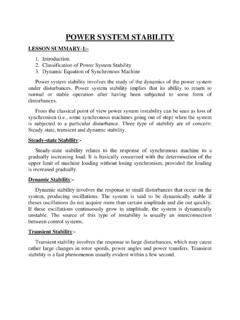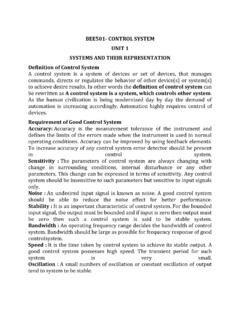Transcription of Research Roadmap on Grid-Forming Inverters
1 Research Roadmap on Grid-Forming InvertersYashen Lin,1 Joseph H. Eto,2 Brian B. Johnson,3 Jack D. Flicker,4 Robert H. Lasseter,5 Hugo N. Villegas Pico,1 Gab-Su Seo,1 Brian J. Pierre,4 and Abraham Ellis4 With editing and support from Hariharan Krishnaswami6, Jeremiah Miller6, and Guohui Yuan61 National Renewable Energy Laboratory2 Lawrence Berkeley National Laboratory3 University of Washington4 Sandia National Laboratories5 University of Department of Energy Solar Energy Technologies OfficeNREL is a national laboratory of the Department of Energy Office of Energy Efficiency & Renewable Energy Operated by the Alliance for Sustainable Energy, LLC This report is available at no cost from the National Renewable Energy Laboratory (NREL)
2 At Contract No. DE-AC36-08GO28308 National Renewable Energy Laboratory 15013 Denver West Parkway Golden, CO 80401 303-275-3000 Technical Report NREL/TP-5D00-73476 November 2020 Research Roadmap on Grid-Forming Inverters Yashen Lin,1 Joseph H. Eto,2 Brian B. Johnson,3 Jack D. Flicker,4 Robert H. Lasseter,5 Hugo N. Villegas Pico,1 Gab-Su Seo,1 Brian J. Pierre,4 and Abraham Ellis4 1 National Renewable Energy Laboratory 2 Lawrence Berkeley National Laboratory 3 University of Washington 4 Sandia National Laboratories 5 University of Wisconsin 6 Department of Energy Solar Energy Technologies Office Suggested Citation Lin, Yashen, Joseph H.
3 Eto, Brian B. Johnson, Jack D. Flicker, Robert H. Lasseter, Hugo N. Villegas Pico, Gab-Su Seo, Brian J. Pierre, and Abraham Ellis. 2020. Research Roadmap on Grid-Forming Inverters . Golden, CO: National Renewable Energy Laboratory. NREL/TP-5D00-73476. NOTICE This work was authored in part by the National Renewable Energy Laboratory, operated by Alliance for Sustainable Energy, LLC, for the Department of Energy (DOE) under Contract No. DE-AC36-08GO28308. Funding provided by the Department of Energy Office of Energy Efficiency and Renewable Energy Solar Energy Technologies Office.
4 The views expressed herein do not necessarily represent the views of the DOE or the Government. This report is available at no cost from the National Renewable Energy Laboratory (NREL) at Department of Energy (DOE) reports produced after 1991 and a growing number of pre-1991 documents are available free via Cover Photos by Dennis Schroeder: (clockwise, left to right) NREL 51934, NREL 45897, NREL 42160, NREL 45891, NREL 48097, NREL 46526. NREL prints on paper that contains recycled content. ii This report is available at no cost from the National Renewable Energy Laboratory at List of Acronyms AGC automatic generation control dq direct quadrature FERC Federal Energy Regulatory Commission FRT fault ride-through IEEE Institute of Electrical and Electronics Engineers IRPTF Inverter-Based Resource Performance Task Force MIGRATE Massive InteGRATion of power Electronic devices NERC North American Electric Reliability Corporation Omega frequency P real power PLL phase-locked loop PV photovoltaic Q reactive power V voltage VAR volt ampere reactive iii
5 This report is available at no cost from the National Renewable Energy Laboratory at Acknowledgments We thank Scott Manson, David Porter, Thibault Prevost, Mariko Shirazi, Vijay Vittal, Dennis Woodford, and Donny Zimmanck for reviewing an earlier draft of this Roadmap . We also thank Dan Ton, Kerry Cheung, Pengwei Du, and Julia Matevosjana for their insightful feedback. iv This report is available at no cost from the National Renewable Energy Laboratory at Executive Summary Managing the stability of today s electric power systems is based on decades of experience with the physical properties and control responses of large synchronous generators, usually with the size of hundreds to even thousands of megawatts.
6 Today s electric power systems are rapidly transitioning toward having an increasing proportion of generation from nontraditional sources, such as wind and solar (among others), as well as energy storage devices, such as batteries. In addition to the variable nature of many renewable generation sources (because of the weather-driven nature of their fuel supplies), these newer sources vary in size from residential-scale rooftop systems (a few kilowatts) to utility-scale power plants (hundreds to even thousands of megawatts) and they are interconnected throughout the electric grid both from within the distribution system and directly to the high-voltage transmission system .
7 Most important for our purposes, many of these new resources are connected to the power system through power electronic Inverters rather than spinning electromechanical machines. Collectively, we refer to these generation technologies as inverter-based This report is intended to provide a comprehensive analysis of the challenges in integrating inverter-based resources and offer recommendations on potential technology pathways to inform the academic community, industry, and government Research organizations. Although the focus of this Roadmap is on Grid-Forming inverter controls, their impact on grid stability , and evaluating crucial system interactions ( , protection), we recognize that the large interconnections in North America will comprise both electromechanical and inverter-based resources (in this Roadmap , sometimes called a hybrid power system ).
8 More importantly, we further recognize that inverter-based resources will comprise both Grid-Forming resources and other forms of control, such as grid-following resources. Transitioning to a grid with more inverter-based resources poses major challenges because the operation of future power systems must be based on a combination of the physical properties and control responses of traditional, large synchronous generators as well as those of numerous and diverse inverter-based resources (see Figure ES-1). These challenges stem from the recognition that there is no established body of experience for operating hybrid power systems with significant amounts of inverter-based resources at the scale of today s North American interconnections.
9 1 Although the focus of this Roadmap is on inverter-based generation, it is also applicable to inverter-based energy storage. The details of Grid-Forming storage applications such as during charging, discharging, or state of charge are beyond the scope of this Roadmap . v This report is available at no cost from the National Renewable Energy Laboratory at Figure ES-1. The present power system (a) has historically been dominated by synchronous generators having large rotational inertia . Future systems (b) will have a significant fraction of inverter-based generation resources.
10 This implies a need for next-generation Grid-Forming controllers that ensure grid stability at any level of penetration with inverter-based resources. This Research Roadmap is intended to fill the knowledge gap by providing a system view of Grid-Forming inverter-based resource controls and their impact on grid stability , which we believe is central to meeting some of the challenges to operating the future North American electric power system . This includes the roles and requirements of Grid-Forming inverter-based resources including solar photovoltaics, wind generators, and energy storage.












